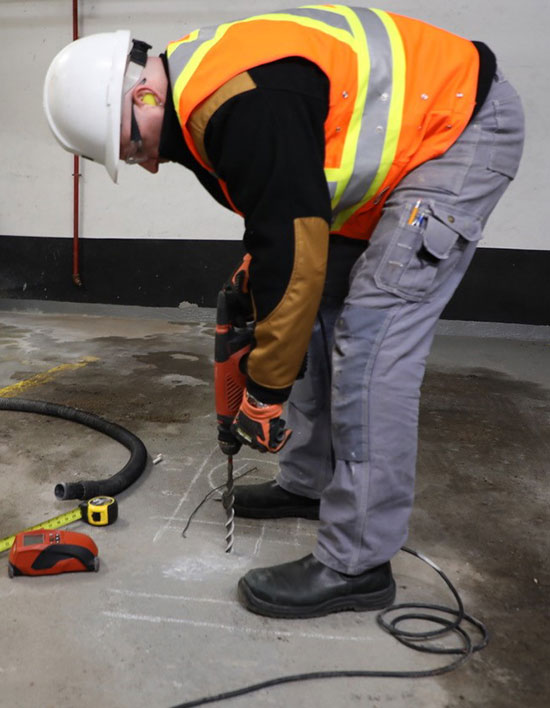Raise Your Reputation and Lower the Complication with These Concrete RH Testing Best Practices, Pt. 2

It is important to Conduct interviews to verify exactly what job site conditions exist prior to concrete slab rh testing
Whether you’re a small, medium, or large scale flooring professional, working on a residential flooring project or commercial flooring project, the fundamentals for success stay the same; be prepared, work with the right tools, work safe, and most importantly, communicate.
Good Communication
So, you’ve got the job. It is precisely at this point where breakdowns can occur that can cost more than dollars . . . your credibility and reputation.
Good, constant, and productive communication with the general contractor, architect, project manager, site-owner, dealer, or even end-user, is vital to the process, and largely overlooked. If you’re reading this and debating whether your current level of communication is adequate, then the goal of this paragraph is fulfilled.
Take the extra steps to initiate and maintain good lines of communication. It is imperative that everyone involved knows what is being commissioned of the testing technician, and the scope of the work that is being proposed.
Conduct interviews to verify exactly what jobsite conditions exist prior to testing. This is often where significant discoveries are made that will prove valuable to the reliability of the test results, not to mention the safety of the testing technicians.
Interviews before the testing process will be helpful for you to determine the age of the structure, slab pour date and depth, suspended slab details, vapor retarder details, buried metals or fiber optics, and more. For example, ASTM F2170 in situ concrete slab moisture testing over suspended corrugated pan decking requires different procedures than testing on-grade or below-grade. A precast, post-tensioned substrate that has been capped with a 1” to 2” leveling pour will require yet another set of skills.
Remember “preparation eliminates pressure,” and maintaining good communication throughout the project is a great way to help ensure your preparedness and to help make sure that your weekend pool party isn’t ruined with angry calls from customers or clients.
The F2170 In Situ Probe Test for Concrete Slab Relative Humidity (RH)
Since this article series references the ASTM F2170 standard regarding concrete moisture testing, let’s cover the salient points of the test process. If you utilize F2170 testing procedure, this will be a good refresher.
If you are thinking of employing the F2170 standard as your procedure to test for RH in concrete slabs, consider this an introduction, but be aware that it is not meant to supersede any information found within the ASTM F2170 standard. To download the ASTM F2170 standard for testing concrete moisture with in situ relative humidity probes, visit https://www.astm.org/Standards/F2170.htm
Correct hole depth and hole diameter are important in complying with the ASTM F2170 standard.

Drill a hole in the concrete slab to the required depth using a rotary hammer drill and a ¾”-diameter masonry drill bit.
Drill a hole in the concrete slab to the required depth using a rotary hammer drill and a ¾”-diameter masonry drill bit. For fast drilling and clean-up in one easy step, the Hilti TE-CD Hammer Drill Bit is a good choice. This is a high-quality drill bit that is long-lasting and gives you a 100% clean concrete hole prior to placing your test sensors. The Hilti drill bit is very convenient to use, plus it saves you time and money because you don’t have to worry about cleaning out the hole. But if you are lacking a drill bit with vacuum capability, Wagner Meters offers a vacuum attachment that you can attach to the straight extension of a shop vacuum cleaner hose. You may need an adapter depending on the vacuum model.
Correct diameter and hole uniformity are absolutely essential to the test procedure. A ¾”-diameter insertion guide, similar to the Smart Sensor Insertion Tool offered by Wagner Meters, will be your diameter and uniformity gauge to ensure a correct and uniformly round hole. Avoiding this step may cause damage to the sensor probe when attempting insertion. If you are testing in thicker slabs, ensure that you have the proper number of extensions to conform to ASTM F2170. Once you have obtained RH readings, you’ll need to evaluate the slab’s readiness for the flooring installation. Consult the respective manufacturers’ installation guides and their specific RH thresholds.
Record, Rinse, Repeat
Always maintain accurate record keeping of obtained results. This is a legal essential no one should ignore. You must be able to produce either date stamped photographic evidence, and/or digitally recorded measurements proving a valid test result. The best testing procedures are no better than the ability to prove an obtained test result of that procedure.
Once the results are delivered, it’s important to be available to discuss findings and to make sure every involved stakeholder understands what the measurable data means.
For more information about Wagner Meters Rapid RH concrete moisture test system, visit https://www.rapidrh.com or call (800) 207-2478.